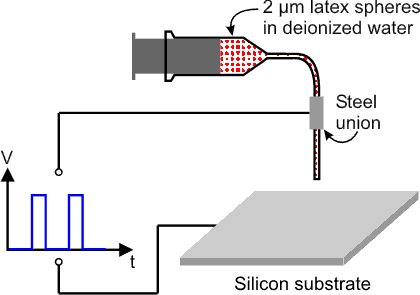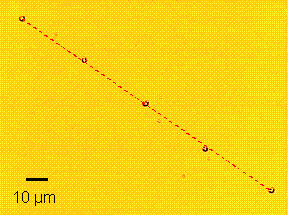Research: Electrohydrodynamic (EHD) Drop-and-Place
Chuan-Hua Chen
Advisors: Dudley A. Saville and Ilhan A. Aksay
Manipulation of small-scale objects such as carbon nanotubes and biological cells is usually achieved by pick-and-place techniques employing scanning probes or robotic tweezers [1]. Pick-and-place suffers from contamination introduced during "picking". More importantly, the instrumental dimension determines the "placing" accuracy; therefore a high positioning accuracy in pick-and-place requires expensive microfabrication. In order to circumvent these drawbacks of pick-and-place we introduce a different paradigm, drop-and-place.
The idea of drop-and-place is to carry small-scale objects (here microspheres) in a liquid drop and deposit them upon solvent evaporation. This no-contact delivery scheme eliminates the contact contamination by design. The positioning accuracy of drop-and-place is strongly dependent on the mechanism used to generate the microspheres-carrying drops. Among contemporary techniques used for drop generation, electrohydrodynamic (EHD) pulsed jetting is the only one which can produce on-demand drops with dimensions at least one order of magnitude smaller than the nozzle [2, 3].
Figure 1 shows the experimental setup for EHD drop-and-place of colloidal particles. Microspheres of 2 µm diameter were homogeneously dispersed in deionized water. The colloidal dispersion was supplied to a 50µm-ID Teflon tube. When a pulsed electric field is applied between the Teflon nozzle and a silicon substrate, drops are generated by each pulsated cone-jet transition. These colloidal drops naturally evaporate, depositing the microspheres on the silicon substrate.

Figure 1: Experimental setup for pulsed electrohydrodynamic jetting
Figure 2 shows a linear colloidal array produced by EHD drop-and-place, where individual 2 µm spheres are positioned with an accuracy of 1 µm. The dosing and positioning accuracy is remarkable given the large inner diameter (50 µm) of the Teflon nozzle. The patterns reported here can be achieved by alternative methods such as colloidal assembly on patterned substrate [4] or other drop generation techniques like ink-jet printing and dip-pen lithography [5]. However, to our best knowledge, EHD drop-and-place is the only method which does not involve any microfabrication (e.g. of the patterned substrate, the nozzle, or the pen).

Figure 2: Electrohydrodynamic drop-and-place of single microspheres
In summary, we have used EHD pulsed jetting to produce colloidal droplets, and to drop-and-place individual 2 µm spheres with a positioning accuracy of 1 µm. Such dosing and positioning accuracies are achieved with a commercial 50 µm ID nozzle without microfabrication. Since the bottom-up self assembly can be further carried out in the colloidal droplets, EHD drop-and-place is a paradigm shift in micro- and nanomanufacturing by integrating bottom-up and top-down engineering and eliminating expensive and time-consuming microfabrication.
For more information on this research topic, please contact Chuan-Hua Chen. Additional information concerning the CML can be found on our website.
References
1. Requicha, A.A.G., Nanorobots, NEMS, and nanoassembly. Proc. IEEE, 91 (11), 1922-1933 (2003)
2. Yogi, O., et al., On-demand droplet spotter for preparing pico- to femtoliter droplets on surfaces. Anal. Chem. 73 (8), 1896-1902 (2001)
3. Basaran, O.A., Small-scale free surface flows with breakup: Drop formation and emerging applications. AICHE J. 48 (9), 1842-1848 (2002)
4. Aizenberg, J., P.V. Braun, and P. Wiltzius, Patterned colloidal deposition controlled by electrostatic and capillary forces. Phys. Rev. Lett. 84 (13), 2997-3000 (2000)
5. Fan, H.Y., et al., Rapid prototyping of patterned functional nanostructures. Nature 405 (6782), 56-60 (2000)
![]()
![]()
![]() © 2006 Princeton University, Ceramic Materials Laboratory.All Rights Reserved.
© 2006 Princeton University, Ceramic Materials Laboratory.All Rights Reserved.


